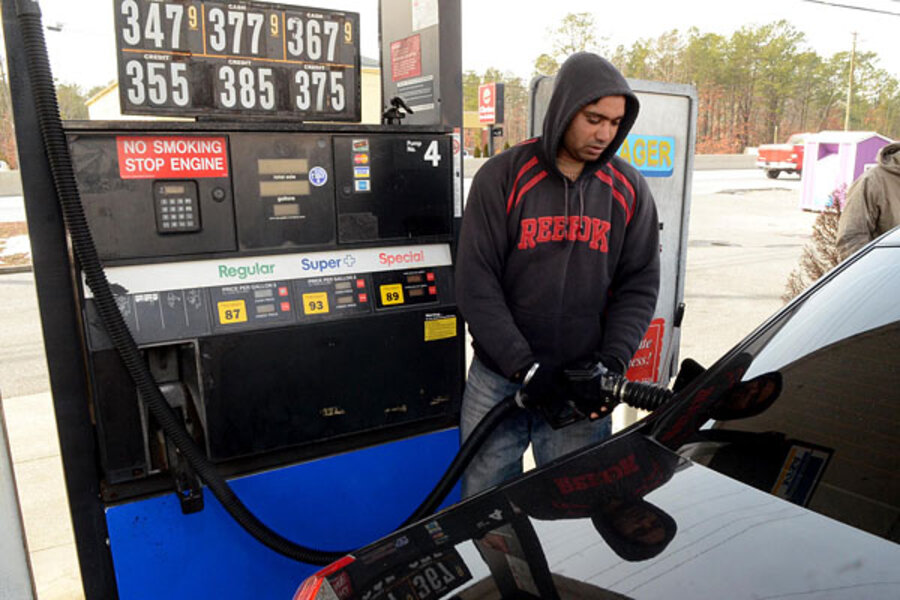Gas prices hit a historic high: What's driving them up?
Loading...
| New York
A combination of high crude prices, refinery shutdowns, and early speculation has sent gas prices soaring to seasonal highs earlier than usual this year, with no signs of prices at the pump falling until spring, according to recent estimates.
Gas prices have climbed every day for the past 25 days, reaching a national average of $3.59 per gallon Monday, the most expensive national average ever for Feb. 11, according to AAA.
During just the past two weeks, average prices have climbed almost 25 cents, the biggest jump in gas prices in almost a year.
“This is a very early rise,” says Tom Kloza, chief oil analyst at the Oil Price Information Service. “January has tended to be a quiet month through the years, but the rally really began in earnest around Jan. 15.”
Gas prices tend to increase in late February as refineries shut down for maintenance ahead of the busy summer driving season.
There are three reasons for the spike, say analysts.
Higher crude prices. This rise, especially overseas, has pushed up prices at the pump, says Michael Green, a spokesman at AAA.
“This year oil prices are rising with expectations that the global economy will continue to improve,” says Mr. Green. “Gas prices are intimately connected to oil prices, [which are] very much connected to what is going on in other parts of the world. Events overseas have a big effect on prices American motorists pay at the pump.”
In fact, crude oil prices have risen 10 percent during the past two months, and the price of crude accounts for almost 70 percent of the cost of a gallon of gas, according to the US Energy Information Administration (EIA).
Seasonal changes. Refineries usually shut down for maintenance in late winter, temporarily reducing gas supplies. As per federal requirements, refineries also begin transitioning at this time of year to summer blend gasoline – a more environmentally-friendly, and expensive, blend to produce. This reduces current winter blend gas supplies.
Financial market speculation. In addition, the rally has been driven by earlier-than-usual speculation that demand for oil will rise, further inflating prices, says Mr. Kloza. In a recent Commodity Futures Trading Commission report, Kloza said he calculated that there is about $45 billion more bet on higher petroleum futures than on lower ones. In other words, more traders expect oil prices to rise in the future than to fall, an expectation that causes oil producers to horde oil in the hopes they can sell it at higher prices later on. That dries up current supplies and translates to higher prices at the pump, which Kloza says we’re already seeing.
“The skew is always bullish, but this is really early for such a one-sided money flow,” he says.
What can consumers expect in the coming months? The bad news, says Green, is that gas prices will continue to rise for the next couple of months.
“Gas prices will continue to rise through April until the seasonal transition process comes to an end,” he says.
But there’s good news: The snowstorm that swept across the northeast Feb. 9 and 10 didn’t damage any pipelines or refineries and kept people off the roads, softening demand and potentially dampening gas prices.
And after last year’s $4-a-gallon-gas-fears, consumers can rest easy that this year’s national average won’t hit the $4 mark. “We’re not expecting that to be the case with the national average,” says Green. “We currently believe it will peak at a lower price than last year,” when gas hit $3.94 a gallon in April.
(No consolation to consumers in some parts of the country, like California, where average prices are already at $4.05.)
Nonetheless, Americans are feeling the pinch. The amount of money they're spending on gas – as a percentage of household income is at nearly 30-year highs. Only 2008 was worse, according to EIA data released last week. In 2012, the average US household spent $2,912 on gas, or almost 4 percent of income before taxes, according to EIA estimates.
Whether or not that’s changing Americans’ driving habits is up for debate.
“We have seen a move toward more fuel-efficient cars, carpooling … using less fuel, and finding gas stations with the best price,” says Green. “But at the same time ... what we find is when gas prices go up, a lot of people have to accept the higher costs.”
Kloza is more skeptical.
“Lest we think that Americans are fed up with high gasoline prices and won’t stand it any more, just take a look at January 2013 vehicle sales,” he says.
“Leading the surge: Ford F-1 vehicles and Chevy Silverados. Hardly fuel-efficient vehicles.”







